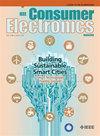Guest Editorial of the Special Section on Generative Artificial Intelligence With Applications on Consumer Electronics
IF 4.3
2区 计算机科学
Q1 ENGINEERING, ELECTRICAL & ELECTRONIC
引用次数: 0
Abstract
Consumer electronics are electronic equipment intended for everyday use, and they constitute a part of the wider electronics industry including devices and services used for entertainment, communications and recreation. In practice, consumer electronics use digital technologies to enhance performance in real-world applications, such as AI-generated content, chatbot, online retailing, automatic driving systems, fashion and apparel industry, etc., where the information in these applications usually generate a significant amount of high-quality data for creation of digital content, Semantic Comprehension or data generation and augmentation, etc. Recently, Generative Artificial Intelligence (GAI) has been gaining significant attention from society. For example, ChatGPT is a language model developed by OpenAI for building chatbot, which can efficiently understand and respond to human language in a logical and meaningful way. In addition, DALL-E-2 is another state-of-the-art GAI model, which is capable of creating unique and high-quality images from textual descriptions in a few minutes. In general, GAI techniques, as opposed to being created by human authors, is to automate the creation of large amounts of content such as images, music, and natural language, etc. Therefore, how to develop robust models for generative AI in this field of consumer electronics is of great importance.生成式人工智能在消费电子产品中的应用》特刊客座编辑
消费电子产品是供日常使用的电子设备,是更广泛的电子产业的一部分,包括用于娱乐、通信和休闲的设备和服务。在实践中,消费电子产品利用数字技术来增强现实世界应用中的性能,如人工智能生成的内容、聊天机器人、在线零售、自动驾驶系统、时尚和服装行业等,这些应用中的信息通常会产生大量高质量数据,用于创建数字内容、语义理解或数据生成和增强等。最近,生成式人工智能(GAI)受到了社会的广泛关注。例如,ChatGPT 是 OpenAI 为构建聊天机器人而开发的一种语言模型,它可以高效地理解人类语言,并对其做出有逻辑、有意义的回应。此外,DALL-E-2 是另一种最先进的 GAI 模型,它能够在几分钟内根据文本描述创建独特而高质量的图像。一般来说,GAI 技术与由人类作者创建的技术不同,它可以自动创建大量内容,如图像、音乐和自然语言等。因此,如何在消费电子产品这一领域为生成式人工智能开发稳健的模型就显得尤为重要。
本文章由计算机程序翻译,如有差异,请以英文原文为准。
求助全文
约1分钟内获得全文
求助全文
来源期刊
CiteScore
7.70
自引率
9.30%
发文量
59
审稿时长
3.3 months
期刊介绍:
The main focus for the IEEE Transactions on Consumer Electronics is the engineering and research aspects of the theory, design, construction, manufacture or end use of mass market electronics, systems, software and services for consumers.

 求助内容:
求助内容: 应助结果提醒方式:
应助结果提醒方式:


